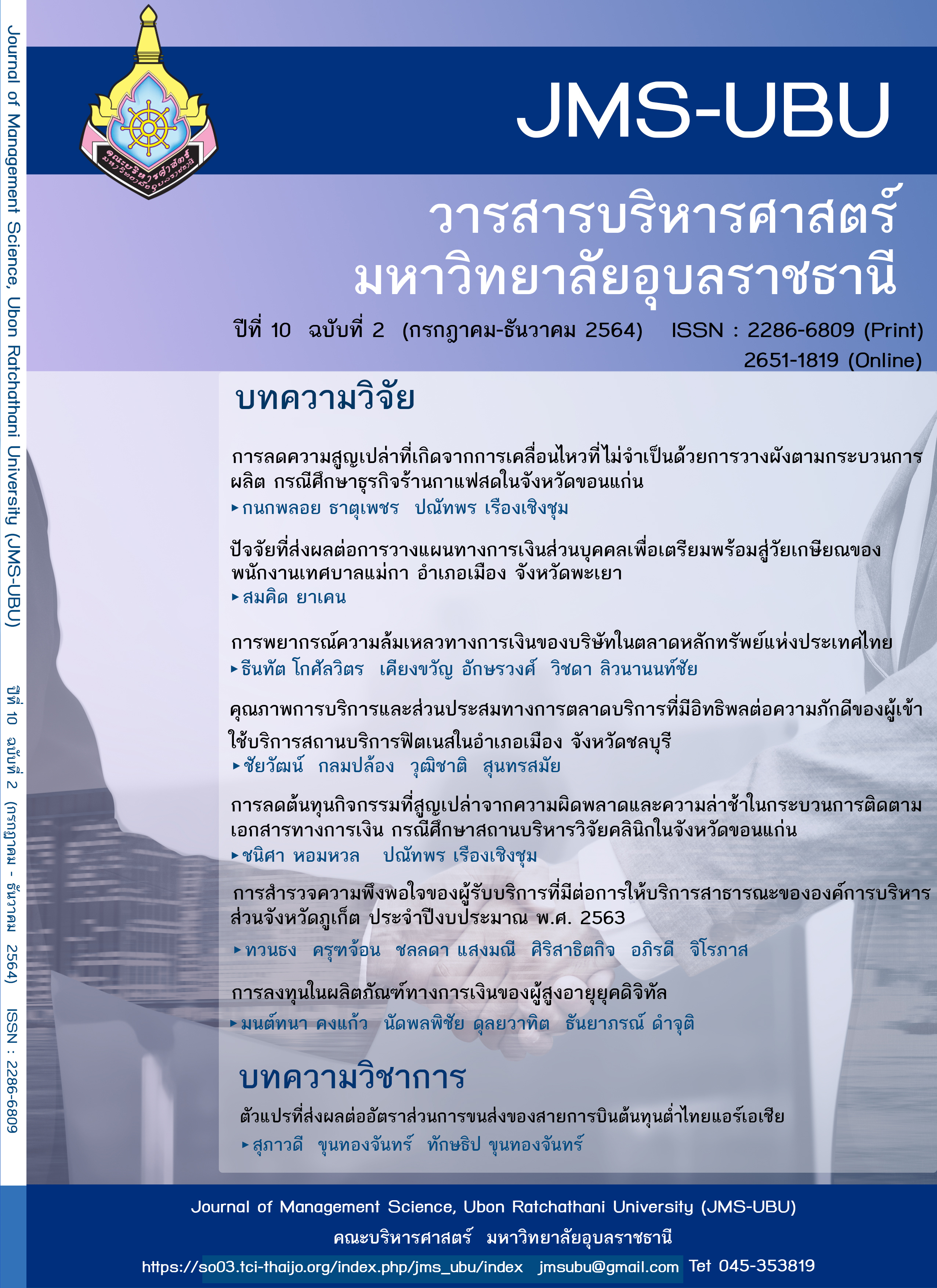การลดต้นทุนกิจกรรมที่สูญเปล่าจากความผิดพลาดและความล่าช้าในกระบวนการติดตามเอกสารทางการเงิน กรณีศึกษาสถานบริหารวิจัยคลินิกในจังหวัดขอนแก่น
Main Article Content
บทคัดย่อ
การลดความผิดพลาดและความล่าช้ามีความสำคัญต่อการลดต้นทุนกิจกรรมที่สูญเปล่าซึ่งเป็นค่าใช้จ่ายที่ไม่จำเป็นหรือไม่ก่อให้เกิดรายได้ในกระบวนการติดตามเอกสารทางการเงิน การวิจัยนี้จึงมีวัตถุประสงค์เพื่อเสนอการลดต้นทุนกิจกรรมที่สูญเปล่าจากความผิดพลาดและความล่าช้าในกระบวนการติดตามเอกสารทางการเงิน โดยเก็บรวบรวมข้อมูลจากการสังเกตแบบมีส่วนร่วมและการสัมภาษณ์เชิงลึกด้วยคำถามปลายเปิดจากผู้ให้ข้อมูลหลักจำนวน 19 คน ร่วมกับการบันทึกความผิดพลาดและระยะเวลาในการปฏิบัติงาน รวมถึงค่าใช้จ่ายจากการปฏิบัติงาน โดยวิเคราะห์ข้อมูลด้วยแผนผังตารางเวลาและวิเคราะห์คุณค่ากิจกรรม ผลการวิจัยพบความสูญเปล่าจากความผิดพลาดเกิดจากกิจกรรมนำส่งและตรวจสอบเอกสารทางการเงิน ขณะที่ความล่าช้าเกิดจากกิจกรรมจ่ายเงินค่าเดินทางและนำส่งเอกสารทางการเงิน จึงส่งผลให้เกิดต้นทุนกิจกรรมที่สูญเปล่าเพิ่มถึง 4,305 บาทต่อเดือน ดังนั้น ผู้วิจัยจึงเสนอแนวทางการลดต้นทุนกิจกรรมที่สูญเปล่าจากความผิดพลาดและความล่าช้าในกระบวนการติดตามเอกสารทางการเงิน พบว่าสามารถลดต้นทุนได้ถึง 3,080 บาทต่อเดือน ผู้วิจัยเสนอให้ผู้บริหารให้ความสำคัญต่อการลดความผิดพลาดและความล่าช้า เพื่อสามารถลดต้นทุนกิจกรรมที่สูญเปล่าในกระบวนการติดตามเอกสารทางการเงิน ซึ่งจะเป็นประโยชน์ต่อการลดค่าใช้จ่ายที่ไม่จำเป็นในการปฏิบัติงานและเกิดประสิทธิภาพในกระบวนการติดตามเอกสารทางการเงินได้ต่อไป
Downloads
Article Details
เอกสารอ้างอิง
กอบกุล สุวลักษณ์. (2560). กระบวนการจัดการในห้องสมุด: การประยุกต์ใช้ “ลีน” เพื่อลดความสูญเปล่าในการจัดทำเอกสารเย็บเล่ม. PULINET Journal, 4(3), 190-198.
เกรียงไกร วงษ์คำอุด และปณัทพร เรืองเชิงชุม. (2563). การลดความสูญเปล่าด้วยการประยุกต์ใช้ต้นทุนฐานกิจกรรมในกระบวนการผลิตยางแผ่นรมควัน กรณีศึกษา สถาบันเกษตรกรในพื้นที่ภาคใต้. วารสารบริหารศาสตร์ มหาวิทยาลัยอุบลราชธานี, 9(1), 122-137.
ณัฐนันท์ อิสสระพงศ์, รัชฎา แต่งภูเขียว, ปิยณัฐ โตอ่อน, อุ้มบุญ เชลียงรัชต์ชัย และพรศิริ คำหล้า. (2562). การลดเวลาในกระบวนการผลิตด้วยแนวคิดการผลิตแบบลีน : กรณีศึกษาการผลิตยางเรเดียล. สมาคมสถาบันอุดมศึกษาเอกชนแห่งประเทศไทย ในพระราชูปถัมภ์ สมเด็จพระเทพรัตนราชสุดาฯ สยามบรมราชกุมารี, 8(1), 76-90.
ถิรนันท์ ทิวาราตรีวิทย์และวรัญญา อวีระพล. (2562). การลดต้นทุนการดำเนินงานในกระบวนการรับผลิตภัณฑ์เข้าคลังสินค้า กรณีศึกษา โรงงานผลิตภัณฑ์บรรจุภัณฑ์ประเภทขวดแก้ว, ใน การประชุมวิชาการระดับชาติ ครั้งที่ 6 วิทยาลัยนครราชสีมา ครั้งที่ 6 ประจาปี พ.ศ.2562 (น.272-281). วิทยาลัยนครราชสีมา.
ทัศนาภรณ์ จิรารักษ์, สุเทพ การุณย์สัญจกร และเกษร ขาวสีจาน. (2556) การพัฒนาประสิทธิภาพการให้บริการงานการเงินและบัญชีเพื่อเสริมสร้างความพึงพอใจของผู้รับบริการในสำนักงานพัฒนาชุมชนจังหวัดสกลนคร. วารสารบัณฑิตศึกษา มหาวิทยาลัยราชภัฏสกลนคร, 10(50), 9-18.
นันทิยากร ลักษณะแก้ว และกาญจนา กาญจนสนุทร. (2559). การเพิ่มประสิทธิภาพในการจัดการเอกสารและการไหลของข้อมูลในองค์กร กรณีศึกษา สำนักงานเศรษฐกิจการคลัง กระทรวงการคลัง. ใน การประชุมสัมมนาเชิงวิชาการประจำปีด้านการจัดการโลจิสติกส์และโซ่อุปทาน ครั้งที่ 16. สืบค้นจาก
https://engineer.utcc.ac.th/upload/Personnel/Publication/kanchana_kan/310_1516938480_37292020.pdf
ประภาพรรณ ศรีมันตะ และปณัทพร เรืองเชิงชุม. (2562). การลดความสูญเปล่าที่เกิดจากการรอคอยในโซ่อุปทานของกระบวนการตรวจวิเคราะห์ทางห้องปฏิบัติการด้านเคมีคลินิก. วารสารเกษตรศาสตร์ธุรกิจประยุกต์, 13(18), 1-14.
ฝ่ายบัญชีและการเงิน สถานบริหารวิจัยคลินิก. (2563ก). Standard Operation Procedures. ขอนแก่น.
ฝ่ายบัญชีและการเงิน สถานบริหารวิจัยคลินิก (2563ข). งบแสดงผลการดำเนินงาน ปีงบประมาณ 2563. ขอนแก่น.
พิเชษฐ์ สิทธิโชคสกุลชัย. (2553). การผลิตแบบลีน สู่การบัญชีแบบลีน. วารสารวิชาการ มหาวิทยาลัยหอการค้าไทย, 30(2), 84-98.
พีระจิตต์ เขียวเล็ก และพีรพงษ์ ฟูศิริ. (2553). สาเหตุของปัญหาในการประยุกต์ใช้แนวคิดอาจายล์ เพื่อการจัดการระบบการพัฒนาโมบายล์แอพพลิเคชั่น. สืบค้นเมื่อ 22 กรกฎาคม 2563,จาก
http://www.utccmbaonline.com/ijbr/doc/(Edit)Id134-11-12-2015_15:16:18.pdf
มาริณี พุทธานุ, บวรวิทย์ โรจน์สุวรรณ และพัฒน์ พิสิษฐเกษม (2561). ปัจจัยสำคัญของการควบคุมต้นทุนฐานกิจกรรม กรณีศึกษาเกษตรกรใน ตำบลเบิด อำเภอรัตนบุรี จังหวัดสุรินทร์. วารสารรังสิตบัณฑิตศึกษาในกลุ่มธุรกิจและสังคมศาสตร์, 4(2), 52-63.
รัตนาภรณ์ ชี้กิ่ง และอาทร จิตสุนทรชัยกุล (2562). ปรับปรุงประสิทธิภาพการทำงานระบบงานเอกสารการนำเข้าเคมีภัณฑ์ด้านการเกษตร กรณีศึกษาบริษัท นำเข้าเคมีเกษตรแห่งหนึ่ง. วารสารบัณฑิตวิทยาลัย, (2), 166-177 สืบค้นเมื่อ 22 กรกฎาคม 2563, จาก
https://grad.dpu.ac.th/upload/content/files/ปีที่%207%20ฉบับที่%202/7-2-16.pdf
ศศวรรณ กลีบบรรจง และวุฒิชัย อารักษ์โพชฌงค์. (2562). แนวทางการพัฒนาเนื้อหาโปรแกรมประยุกต์ตามคุณลักษณะที่จำเป็นเพื่อสนับสนุนการสื่อสารภายในองค์การของกลุ่มบริษัทอุตสาหกรรมน้ำตาลแห่งหนึ่งในกรุงเทพมหานคร. วารสารสังคมศาสตร์บูรณาการ, 6(1), 207-238.
สนั่น เถาชารี และระพีพันธ์ ปิตาคะโส. (2555). การประยุกต์ใช้แผนผังสายธารคุณค่าในการเพิ่มประสิทธิภาพการจัดการโลจิสติกส์และโซ่อุปทานข้าวในภาคตะวันออกเฉียงเหนือของประเทศไทย. วารสารวิจัย มข., 17(5), 687-705.
สุภัทรพงษ์ สนอุทาและปณัทพร เรืองเชิงชุม. (2563). การลดความสูญเปล่าที่เกิดจากความล่าช้าในกระบวนการติดตามเอกสารทางการเงินด้วยการประยุกต์ใช้แนวคิดห่วงโซ่อุปทาน 4.0. วารสารบริหารศาสตร์ มหาวิทยาลัยอุบลราชธานี, 9(1), 38-54.
อัญชุลี เรืองพลับพลา, รวิวงศ์ ศรีทองรุ่งและศิริมา ตันติธำรงวุฒิ. (2560). ทัศนคติของนักวิชาการเงินและบัญชี มหาวิทยาลัยมหิดลที่มีต่อการบริหารจัดการความสูญเปล่าตามแนวคิดแบบลีน. วารสารมนุษย์ศาสตร์และสังคมศาสตร์ มหาวิทยาลัยเอเชียอาคเนย์, 1(1), 1-10.
อำพล สุบรรณ์พิจิตร, ศักดิ์ชาย รักการ, อัตถกร กลั่นความดี และธนาคม สกุลไทย์. (2560). การพัฒนากระบวนการการกำกับและติดตามโครงการจ้างปรึกษาแนะนำธุรกิจขนาดกลางและขนาดย่อม. วิศวกรรมสารเกษมบัณฑิต มหาวิทยาลัยเกษมบัณฑิต, 7(1), 78-91.
Adler, R. W. (2018). Strategic Performance Management Accounting for Organizational Control. New York: Routledge.
Amariglio, A., & Depaoli, D. (2020). Waste management in an Italian hospital's operating theatres: An observational study. American Journal of Infection Control, 49(2), 184-187.
Ciambrone, D. (2008). Effective Transition from Design to Production. New York: Boca Raton.
Cugini, A., Caru, A., & Zerbini., F. (2007). The cost of customer satisfaction: A framework for strategic cost management in service industries. European Accounting Review, 16(3), 499-530.
Figge, F., & Hahn, T. (2005). The cost of sustainability capital and the creation of sustainable value by companies. Journal of Industrial Ecology, 9(4), 47-58.
Goldstine, H. H, & Neumann, J. V. (1947). Flow chart of planning and coding of problems for an electronic computing instrument. Wikimedia Commons. Retrieved August 12, 2020, from
Heizer, J., Render, B., & Munson, C. (2016). Principle of Operations Management: Sustainability and Supply Chain Management (10th. ed.). New York: Pearson.
Kurokawa, Y., (2010). M&A for Value Creation in Japan (6thed.). Singapore: World Scientific.
Mahal, I., & Hossain, M. A. (2015). Activity-based costing (ABC). An effective tool for better management. Research Journal of Finance and Accounting, 6(4), 66-73.
Martin, J. W. (2009). Measuring and Improving Performance: Information Technology Applications in Lean Systems. CRC Press.
Ozkan, S., & Karaibrahimoglu, Y. Z. (2012). Activity-based costing approach in the measurement of cost of quality in SMEs: a case study. Total Quality Management & Business Excellence, 24(3-4), 420-431.
Spinelli, R., & Visser, R. J. M. (2009). Analyzing and estimating delays in wood chipping operations. Biomass and Bioenergy, 33(3), 429-433.
Stapleton, D., Pati, S., Beach, E., & Julmanichoti, P. (2004). Activity-based costing for logistics and marketing. Business Process Management Journal, 10(5), 584-597.
Stellman, A. & Greene, J. (2014). Learning Agile: Understanding Scrum, XP, Lean, and Kanban (1st ed.). California: O'Reilly Media, Inc.
Tsai, W. H., Chen, H. C., Liu, J. Y., Chen, S. P., & Shen, Y. S. (2011). Using activity-based costing to evaluate capital investments for green manufacturing systems. International Journal of Production Research, 49(24), 7275-7292.

